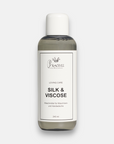


Silk & Viscose Care Detergent
Silk & Viscose Care Detergent 240ml - Care specifically tailored to the silk fiber. Colors remain brightly fresh and the silk is soft and supple. Suitable for machine and hand washing.
This item cannot be returned for hygiene reasons.
Material Composition:
Care:
Model size:
Pattern size: *
Bust width:
Total length: Bottle approx. 16 x 4 cm / 240 ml
More information in the shipping conditions
returns are subject to a charge.
Bought together
Why are there special detergents for silk and viscose?
Silk and viscose are among the delicate fabric en that require special care. Normal detergents are not suitable for these materials as they often contain aggressive ingredients such as bleach, enzymes or optical brighteners. These substances can cause significant damage to the fiber structure of silk and viscose.
Silk is a natural fibre obtained from the cocoons of the silkworm. Its protein structure is sensitive to alkaline substances contained in many conventional detergents. silk clothing If washed with an unsuitable detergent, it can lose its softness, shine and even color. In addition, silk is susceptible to mechanical friction, which can lead to a rough and dull surface if washed improperly.
Viscose, on the other hand, is a semi-synthetic fiber made from cellulose. Although it feels soft and silky, it is very sensitive when wet. Conventional detergents can cause the fibers to swell or even damage them. This often leads to viscose losing its shape or becoming brittle. Special care detergents for silk clothing e and viscose protect the sensitive fibers, preserve the colors and clean gently.
Such detergents have a mild formula that is free of enzymes and aggressive chemicals. Instead, they contain nourishing substances that support the fiber structure and clean the textiles gently. The result: garments made of pure silk e and viscose stay beautiful longer and feel like new even after repeated washing.
What is the advantage of liquid detergent over powder?
Liquid detergents have several advantages over washing powder when it comes to caring for silk and viscose. Since they dissolve in water more quickly and without leaving any residue, there is no risk of detergent residue damaging the fibers or leaving unsightly stains. In addition, liquid detergents are often formulated more gently, which is particularly useful for delicate fabric en is important. Powders, on the other hand, can act like abrasive particles due to their solid components and roughen the surface of the fabric. This is why liquid detergents are the best choice for gently cleaning delicate textiles such as silk and viscose.
Washing silk - How to keep the noble fabric supple
Silk is known for its luxurious shine, softness and airy lightness. At the same time, however, it is also a delicate fabric that can quickly lose quality if not cared for properly . In order to keep silk supple and preserve its noble character, careful treatment when washing is essential.
- Preparation: Before washing silk, read the care label carefully. Some silk fabrics are only suitable for dry cleaning, others for hand washing or the gentle cycle of the washing machine. Dark or heavily colored silk fabrics can bleed, so it is recommended to test these separately before the first wash.
- Hand washing: The safest method to real silk To clean it, hand wash it. To do this, fill a bowl or sink with lukewarm water (max. 30 °C) and add the special liquid detergent for silk, of course from Princess goes Hollywood . Gently swirl the garment in the water without rubbing or wringing, as this could damage the delicate fibres. After a few minutes, remove the garment and rinse with clear, lukewarm water rinse.
- Machine wash: If the care label allows washing in the machine, always select the gentle wash program and keep the spin cycle as low as possible. low speed Use a laundry net to protect the silk from friction and mechanical stress. Avoid using fabric softener as this can damage the fibers.
- Drying and ironing: Silk should never be wrung out after washing. Gently squeeze out excess water, lay the garment flat on a clean towel and roll it up to absorb the moisture. Then let it air dry, but not in direct sunlight, as this may cause the colors to fade. Iron silk while still slightly damp at a low temperature to remove wrinkles.
viscose fabric washing - This is what you should definitely pay attention to
Viscose is a versatile fabric that is valued for its soft, silky drape. However, like silk, viscose requires special care as it is sensitive to water and mechanical stress.
- Preparation: Before washing viscose, check whether the garment is machine washable. Some viscose fabrics are particularly delicate and should only be washed by hand. To make sure that the colors do not fade, you can do a color test on an inconspicuous area.
- Hand washing is the most gentle method: For hand washing, fill lukewarm water in a bowl and add the liquid detergent from Princess goes Hollywood , which is especially suitable for delicate fabrics. Gently swirl the garment in the water without rubbing, as wet viscose fibers can tear very easily. After a few minutes you can take the garment out of the water and rinse thoroughly with clear water rinse.
- Machine wash: If viscose can be machine washed, then make sure to use the gentle cycle at a maximum of 30 °C. Use a laundry net to protect the garment from mechanical stress. Choose a low spin speed, as viscose is particularly susceptible to deformation when wet.
- Drying properly : After washing, viscose should never be wrung out. Instead, gently squeeze out the excess water and lay the garment flat on a towel. Gently pull into shape and allow to air dry. To remove creases, viscose can be ironed at a low temperature while still slightly damp.
- Additional tips: Do not hang viscose when wet, as the weight of the water can damage the fabric. Also, avoid tumble drying if possible, as the high heat can damage the fibers and cause the garment to shrink.
How to remove odors from delicate fabric en?
smells in delicate fabric Fabrics such as silk and viscose can be stubborn, but can be gently removed with the right care. Instead of aggressive detergents or high temperatures, we recommend our special liquid detergent for delicate fabrics, which is also low temperature For particularly stubborn odors, a gentle vinegar bath helps: Add 1-2 tablespoons of vinegar to lukewarm water dilute, soak the garment for 10 minutes and then rinse with the detergent from our online shop. A short steam treatment, for example with a steam iron, can also help to neutralize unpleasant odors without damaging the fibers. Sometimes just hanging the item in the fresh air for a short time can remove some bad odors.
Our favourites



















